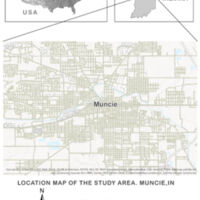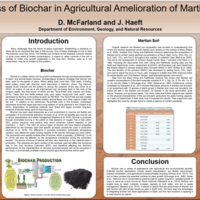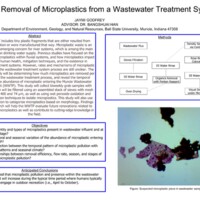Browse Exhibits (5 total)
Abdulgadir Elnajdi | Spatial analysis of lead-contaminated soil properties using geographic information system (GIS)

The study of the health issues caused by environmental factors such as lead-contaminated soil requires reliable information on soil properties' spatial distribution. Lead-contaminated soil resulting from gasoline, paint, and industrial pollution is still a severe source of lead for young children in the United States. Lead is associated with health risks such as kidney diseases, bone diseases, and affected regions inside the brain responsible for executive functions in the human body. Centers for Disease Control and Prevention (CDC) highly advise that public health measures start when a child's blood lead level is five µg/dL. A blood lead concentration (BLL) of greater than ten µg/dL at an early age could cause long-lasting health effects. In 2014, children in Indiana were screened for Lead, and approximately 4.3 % (0 1,765 out of 40,811) Hoosier children were at or above the CDC standard of five µg/dL (Health and Program, 2014). The lead levels found in Muncie's soil are concerning. The evaluation of the spatial distribution of soil properties [soil lead content, soil pH, soil texture, Etc.] is essential to assess the health concerns in Muncie, and it is one of the bases for decision and policymakers to make designs and strategies to fix the issues.
Researchers in environmental monitoring with geographic information system (GIS) can generate high-quality maps. The objective of this study is to investigate the interactions between total lead and bioaccessible Pb with blood lead levels of Muncie residents. Furthermore, examine the soil properties such as soil texture, pH, and organic matters to add more information about the possibility of lead mobility in Muncie's soil.
Faculty mentor: Dr. Adam Berland
Department of Environment, Geology and Natural Resources
Graduate
Brooklyn Boatright | Nature, Timing, and Tectonic Implications of Crystallization and Metamorphic Phases of Leucogranites in the Mt. Everest Region, Nepal, Using Zircon U-Pb Geochronology

Leucogranites are an igneous granitic rock with very few dark minerals. They are a significant characteristic of the Himalayan mountains and located throughout, but their formation history and evolution in the Himalayan region are understudied and unclear. Himalayan leucogranites contain mineral geochronometers, which selectively incorporate radioactive isotopes during formation, and can be dated using the known half-life of their isotopes. Zircon is one mineral geochronometer that contains three unique decay series collectively known as the uranium/lead (U/Pb) system. These isotopes can be dated, then checked against one another to determine the accuracy and precision of resultant age dates. Similarly, the depletion or enrichment of light rare-earth elements (LREEs) and heavy rare-earth elements (HREEs) has geologic implications: they may indicate the mode of magma generation and/or determine a rock’s mineral assemblage.
The Himalayan leucogranites’ age dates will determine when the parent magma crystallized, give insight into local fault movement timing, and clarify the number of metamorphic phases the leucogranites underwent. Additionally, further implications include: broadening geologic literature regarding mountain evolution following continental collision, which can be used globally to understand other mountain-building events; explaining the process of deep subsurface magma generation; and ascertaining the probability of viable ore deposits associated with leucogranites. If the presence of ore and rare-metal mineral deposits are confirmed, they may stimulate the local economy by providing resources for metal-workers, miners, and artisans. This study aims to answer three questions regarding the Himalayan leucogranites’ formation and evolution:
- What is the crystallization age of the Mt. Everest region leucogranites?
- How many metamorphic phases did the leucogranites undergo?
- Can the age dates and trace/rare-earth element (t/REE) geochemistry be used to:
- Constrain local fault movement timing
- Determine the probability of economic ore and rare-metal mineral deposits associated with Himalayan leucogranites?
Eight leucogranite samples were collected May-June 2018 along the Everest Base Camp trekking path. National Petrographic Laboratory made thin sections of six samples in December 2020. Petrographic analysis began in January 2021 to identify mineral assemblages and metamorphic features and will continue to October 2021. All eight samples have been crushed according to standard mineral separation practices and four were sent to the Arizona LaserChron Center (ALC) in February 2021 to finalize mineral separation. LA-ICP-MS and SHRIMP will be utilized to determine the t/REE composition and zircon age of the leucogranites. Plans have been made to travel directly to ALC in May 2021 to conduct instrument analyses. Expected results are Miocene-age zircon dates, 2-3 metamorphic phases, a range of timing for the South Tibetan Detachment's motion of about 20 Ma, and the presence of rare-metal minerals apparent in thin section.
Faculty Mentor: Dr. Kirsten Nicholson
Secondary Mentors: Dr. Jeff Grigsby and Dr. Klaus Neumann
Department of Environment, Geology, and Natural Resources
Graduate Student
David McFarland | The Effectiveness of Biochar on Nutrient Retention in Martian Soil Simulant

This project will study the effects of biochar application on essential nutrient retention in a Martian soil simulant, Mojave Mars Simulant 2 (MMS-2). A potted plant experiment will be conducted using soybean plants planted in MMS-2, with and without biochar and fertilizer. It is hypothesized that the application of biochar will enhance benefits from fertilizer used with the simulant.
Faculty Mentor: Dr. Jessi Haeft
Department of Environment, Geology, and Natural Resources
Graduate
Emily Hayes | Peace and Water in the Khumbu- Mitigating Conflict by Integrating Peacebuilding Tools into an Indigenous Water Management Framework
Threats of climate change and increasing foreign tourism have extraordinary impacts on drinking water quality and availability for the indigenous and local people of the Sagarmatha National Park (SNP), Nepal. The purpose of this study is to expand on six years of previous water quality research of the SNP, focusing on local indigenous water management practices and the dynamic relationship between water management and peace. Using a mixed-methods, participatory action research approach, this study intends to: (1) understand local and tourist perceptions and attitudes regarding water resource management; (2) identify possible conflicts associated with water resources; and (3) develop community action strategies and a community-based plan of action to address water quality issues related to conflict.
Faculty Mentor: Joshua Gruver
Secondary Mentors: Dr. Kirsten Nicholson, Dr. Subodh Sharma
Dept. of Environment, Geology, and Natural Resources
Graduate Student
Jaymi Godfrey | Removal of Microplastics from a Wastewater Treatment Plant System

“Microplastic” includes tiny plastic fragments that are either resulted from plastic degradation or were manufactured that way. Microplastic waste is an contaminant of emerging concern for river systems, which is among the main sources of human drinking water supply. Previous studies have focused on the prevalence of microplastics within fluvial systems, and how microplastics impact wildlife and human health, mitigation techniques, and the existence in wastewater treatment systems. However, rates and mechanisms of microplastic removal during the wastewater treatment system process are still unclear. The focus of this study will be determining how much microplastics are removed per each stage of the wastewater treatment process, and reveal the temporal variations of the abundance of microplastic entering the Muncie Wastewater Treatment Plant (WWTP). This study will collect biweekly grab samples with duplicates which will be filtered using an assembled stack of sieves with mesh sizes between 400 and 74 µm, as well as using wet peroxide oxidation and density separation techniques to isolate microplastics. This study will also use visual identification to categorize microplastics based on morphology. Findings from this research will help the WWTP evaluate future renovations related to the removal of microplastics as well as contribute to cutting-edge knowledge in the field.
Faculty Mentor: Bangshuai Han
Environment, Geology, and Natural Resources
Graduate
